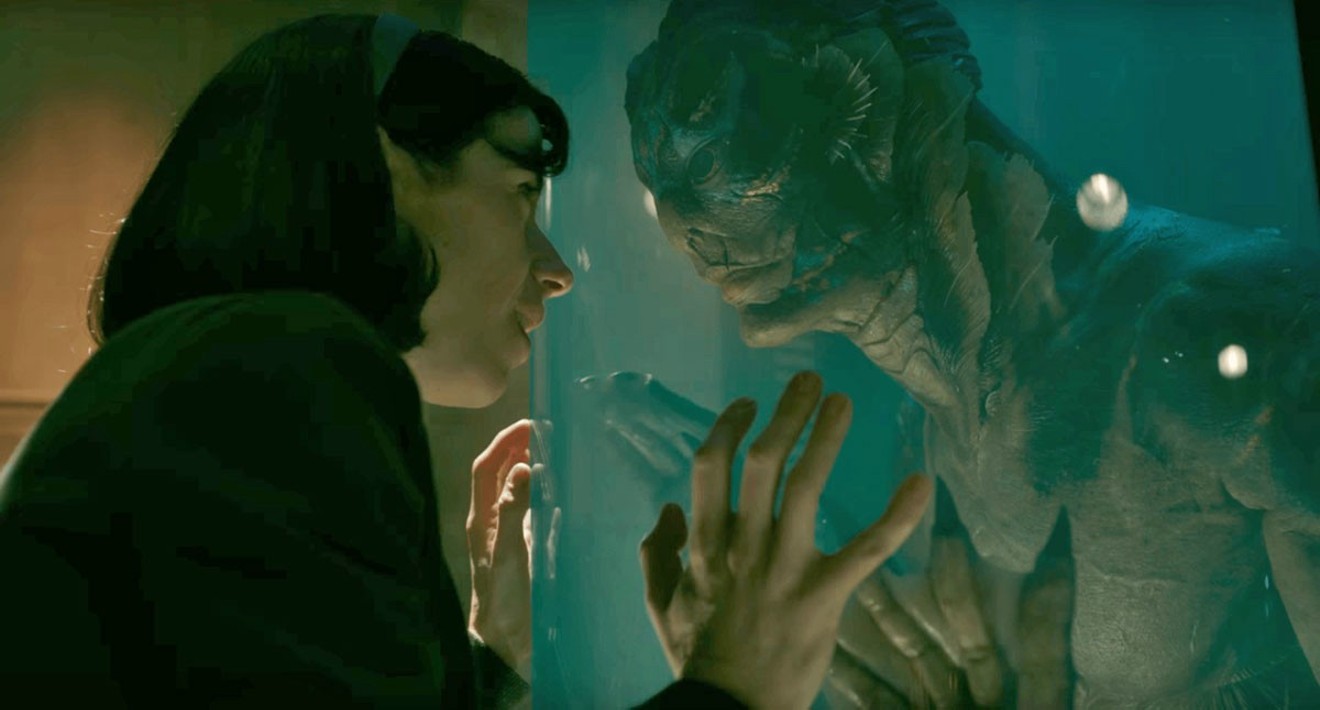Guillermo del Toro is a Visionary with a capital V, a madman-auteur who imagines nutty, intricate universes and populates them with magical figures both sinister and angelic — but perhaps his greatest skill lies in getting the hell out of the way when he has a great actress before his cameras. Del Toro might have made The Shape of Water, but Sally Hawkins owns it.
It’s set in the 1960s in one of those fantasy worlds that seem a slight degree removed from our own. Elisa (Hawkins) is a mute dreamer who spends her days taking care of an introverted, awkward artist (Richard Jenkins) — their apartments are situated directly above an old picture palace, because of course — while also doing janitorial work at a secret military lab that appears to house experimental weapons and strange artifacts. Her best friend there, Zelda (Octavia Spencer), fills the air around the silent Elisa with her lively chitchat. One day, into their building sweeps Richard Strickland (Michael Shannon), a paranoid, electric-cattle-prod-wielding government agent transporting a large container filled with murky water. Inside the muck is … well, some sort of lizard-man (played by del Toro regular Doug Jones) that Strickland captured down in South America. Intrigued, Elisa finds herself drawn to the creature, whose silence — not unlike hers — seems to mask deep swells of feeling; they’re both submerged, each in their own way. Also curious about the creature? The Soviets, who have a spy in the lab.
For all of del Toro’s imaginative prowess, The Shape of Water is a fairly familiar story, a hybrid of oddball romances and fantastical-creature-lost-on-Earth movies — sort of like that dream you once had where the lead character from Amelie seduced the Creature from the Black Lagoon. (Surely, I wasn’t the only one?) But del Toro can take tired ideas and make them feel new again. He invests every moment here with dazzling design and otherworldly atmosphere. Early scenes play like parts of an ornate and unforgiving machine, with egg timers and time clocks and calendars and repetitive motions in Elisa’s workplace creating a sense of life ticking away, of the great contraption of being whirring and consuming these characters.
Later, however, the movie purposefully dips and drifts; del Toro lets the clockwork malfunction, as if the quiet connection of these two strange loners has upended the relentless march of time. And just as the story should start to speed up and get more predictably exciting, it becomes weirder, drawn to odd tangents. There’s even a bizarro dance sequence late in the film, a Fred Astaire fever dream that somehow both enlivens and underscores the characters’ melancholy.
But while del Toro can create the machinery, and even disrupt it in pointed ways, it’s Hawkins who has to carry the load. Elisa can’t speak, so the movie’s emotional turns play out on her face: her curiosity for this creature, her growing affection (and, eventually, her passion) for it. The warmth of her glance humanizes everyone else — including Jenkins’s sad-eyed painter, who is broken in all sorts of ways but still seems to hold out hope for a better tomorrow. Even Shannon’s severe G-man would come off as frustratingly one-note if Elisa, like a true innocent, didn’t show some quiet concern for him as well.
And yet, Hawkins never overplays it. Hers is one of the most expressive faces on the planet, and it would have been so easy to go over the top with the role of a mute, mousy romantic — to fill the character’s silences with angular, expressive grotesquerie. But throughout this whole thing, she remains life-size and real. It speaks both to del Toro’s confidence and generosity that, having designed this world so thoroughly, he essentially hands the whole thing over to Hawkins — not just so she can breathe life into her own character, but so she can conjure all the emotional connections required for any of this to work on any level. And my God, how she runs with it.
[
{
"name": "Air - MediumRectangle - Inline Content - Mobile Display Size",
"component": "18478561",
"insertPoint": "2",
"requiredCountToDisplay": "2"
},{
"name": "Editor Picks",
"component": "16759093",
"insertPoint": "4",
"requiredCountToDisplay": "1"
},{
"name": "Inline Links",
"component": "17980324",
"insertPoint": "8th",
"startingPoint": 8,
"requiredCountToDisplay": "7",
"maxInsertions": 25
},{
"name": "Air - MediumRectangle - Combo - Inline Content",
"component": "16759092",
"insertPoint": "8th",
"startingPoint": 8,
"requiredCountToDisplay": "7",
"maxInsertions": 25
},{
"name": "Inline Links",
"component": "17980324",
"insertPoint": "8th",
"startingPoint": 12,
"requiredCountToDisplay": "11",
"maxInsertions": 24
},{
"name": "Air - Leaderboard Tower - Combo - Inline Content",
"component": "16759094",
"insertPoint": "8th",
"startingPoint": 12,
"requiredCountToDisplay": "11",
"maxInsertions": 24
}
]











